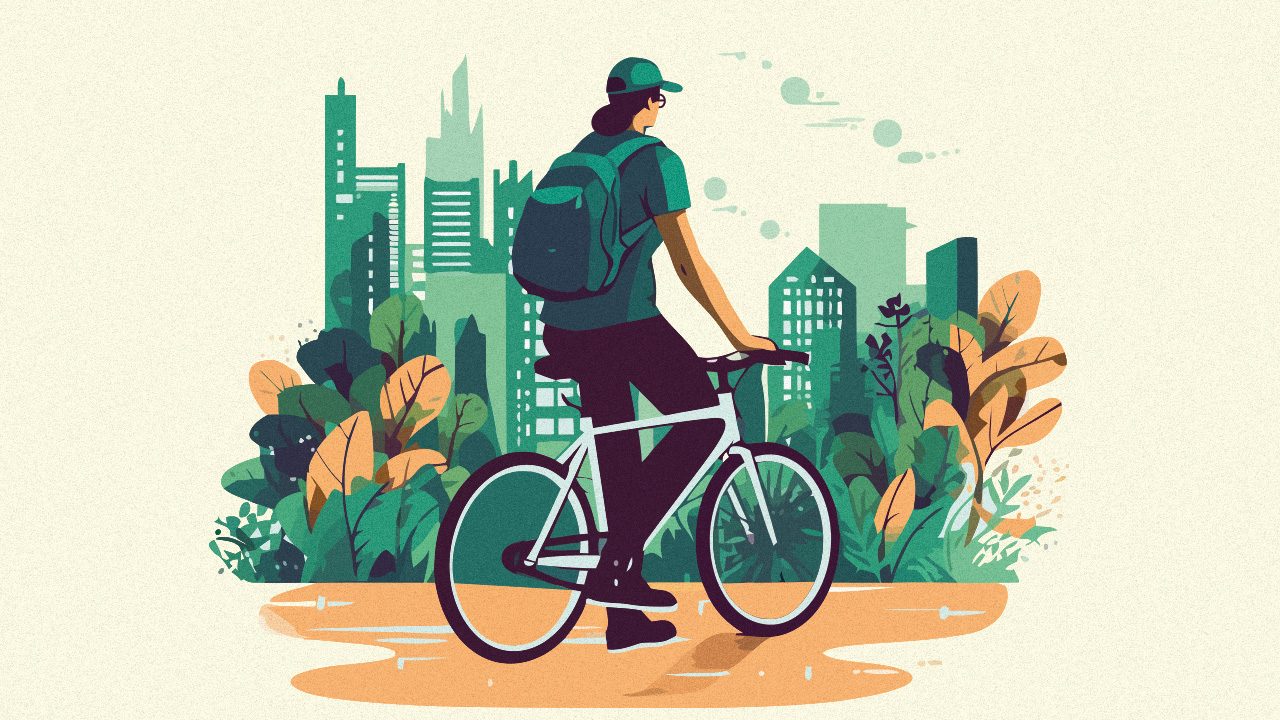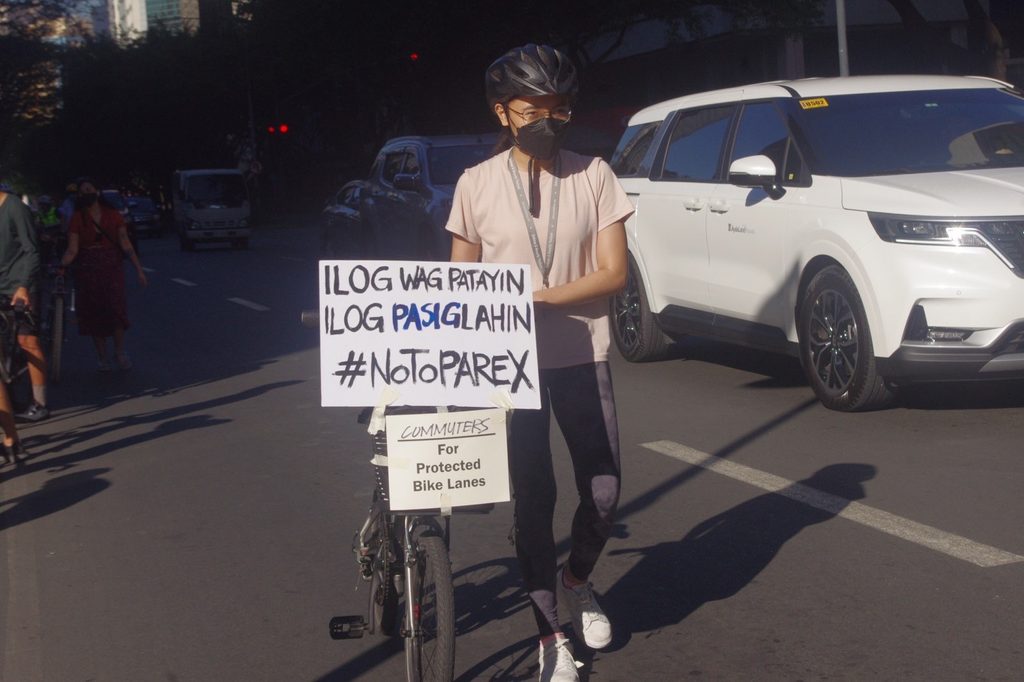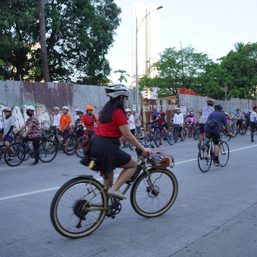SUMMARY
This is AI generated summarization, which may have errors. For context, always refer to the full article.

MANILA, Philippines – Alyssa Belda, a 23-year-old interior design fresh graduate, is part of a new generation finding freedom in cycling and mobility after relying on cars and other emissions-heavy vehicles for years.
Though she started cycling only in 2021, she was already concerned about the limited urban transport as early as when she was 12. Her advocacy for improved transport options eventually led her to join the Move as One Coalition, where she uses her design background to champion “green spaces and [keep] our heritage intact.”
Belada is not alone in this newfound call for greener transport options. Many turned to cycling when the COVID-19 pandemic forced governments to restrict public transit, ushering in the importation of 2.1 million bikes to the Philippines in 2020. In 2022, a Social Weather Stations (SWS) survey found that around 4.5 million people aged 18 to 44 comprised the biking population in the country.
Keisha Mayuga, an environmental planner and cycling advocate long before the pandemic, has observed an increase in the number of young people cycling due to awareness of the transport sector’s contribution to climate change and the cost of owning cars.
“It used to be that having a car acted as a symbol for ‘making’ it in life. But now, we’re seeing a trend where more young people don’t want to own a car because it’s impractical and expensive or you get stuck in traffic a lot,” said Mayuga, who recently finished her MBA in sustainable mobility.
“Most of the people I hang out with are young people cycling because they’re my age, of course. But more than that, young people are becoming more and more aware of climate change and social issues, which is really great because we didn’t have this before.”
Cycling as green mobility
The International Council for Local Environmental Initiatives used the term “green mobility” as early as 2012 to refer to modes of active transportation such as cycling and walking, as these do not rely on fossil fuels. According to the Intergovernmental Panel on Climate Change, the transport sector is responsible for around one-seventh of global carbon dioxide emissions.
Due to the emissions from cars, the United Nations is promoting more active mobility to achieve Goal 11 of the Sustainable Development Goals (SDGs), which states that cities and human settlements must be “inclusive, safe, resilient, and sustainable.” Cycling, as a form of mobility, was deemed vital to fulfilling the SDGs since it is affordable, safe, and non-polluting.
Numerous studies supporting cycling as a sustainable mode of transport and active mobility have been published. A 2022 study also found that if everyone in the world cycles 1.6 kilometers (km) every day, around 414 million metric tons of carbon emission could be offset.
However, Mayuga said that arguments about the transport sector’s contribution to climate change are insufficient to convince other people to pick up cycling. Others are more convinced when she explains the economic benefits of this alternative mode of transport.
Still, just the simple act of picking up a bike is already an influential message in itself, she added.
“Before the pandemic, I was cycling by myself, and people were saying, ‘You’re not reversing the greenhouse gases by making a longer cycling trip to work every day,'” Mayuga recalled.
“It’s not actually just about the act of cycling; it’s convincing or telling people it’s possible. You’re making it possible for people to see, think about, and reconsider cycling, which is so much more powerful than when you compute your GHG emissions daily,” she added.
In several cities in Asia, cycling is considered a legitimate form of transportation not only because of its environmental benefits, but also because it is already an integral part of their culture. Tokyo ranks 16 among the top 20 most cycling-friendly cities in the Copenhagenize Index, thanks to its prominent biking culture. Around 8.4 million of its citizens regularly cycle, and one can avail of a bike insurance for less than ¥5,000 or P2,000 a year.
Taipei is also a successful example of how a dense Asian city can gradually incorporate cycling into its urban development in just a decade. Taipei was nicknamed the “Bicycle Kingdom” after implementing its “YouBike” bike share scheme in 2009. This spurred an increase in cycling infrastructure, such as bike lanes, and pushed the city to rank 17 in the Index.
Sustainable mobility in the Philippines
Back in the Philippines, the construction of better cycling infrastructure only sped up when public transportation shut down by mid-2020.
The national government – with financial and technical support from the World Bank Philippines Transport Team, the Global Road Safety Facility (GRSF), and the Australian government – swiftly constructed 500 kilometers of bike lanes along national roads in less than a year to cater to an uptrend of bike users.
Marikina recently completed a 52-kilometer bikeway network, while Pasig became the first local government unit (LGU) to consider cycling as an essential means of transport.
LGUs outside of Metro Manila, such as the cities of Cebu and Davao, have also been making progress in securing better cycling infrastructure by implementing more bike lanes.
While Mayuga commends the progress on bike lanes, she said there is still a lack of protective infrastructure. According to an INQUIRER.net report, cycling mishaps increased by 48% in 2020, translating to 2,606 recorded accidents from 1,759 of the previous year.
The National Economic and Development Authority adopted the National Transport Policy in 2020, with the implementing rules and regulations stipulating that cycling and walking should be integrated into road infrastructure. But Eldon Dionisio, manager of the Department of Transportation’s (DOTr) Active Transport Program Management Office, said that passing a law can further reinforce this.
Bills mandating the construction of bike lanes across main roads and designating parking areas are still pending with committees in both houses of Congress.
“When you have a national statute, wala [nang] magagawa ‘yung [national government] agencies (there’s nothing national government agencies can do to stop it),” Dionisio added. “At the moment, we [at the DOTr] are being met with apprehensions from selected agencies, both national and local. Sayang daw ‘yung space (They say it’s a waste of space).”
Belda added that ensuring better biking policies should also be a collaborative effort between local governments and their cycling communities. She cited the meetings on biking infrastructure held every month by the Quezon City government.
“We don’t want it to just be like, ‘Okay, so here are the plans, and we want you to give feedback.’ No, we want to be included from the beginning. We should build this together,” Belda said.

Challenges to greening
Though there has been significant progress toward building better cycling infrastructure, these developments still face bureaucratic obstacles and cultural resistance.
Cycling in the Philippines can also be impractical and even dangerous when considering existing transport conditions. About 34% of respondents in a nationwide 2022 survey said they sometimes travel for more than 11 km. The study also indicated that safety against crimes was a top concern among respondents when choosing bike routes. Respondents likewise considered reducing cycling frequencies due to warm weather.
Another 2020 study by the labor department’s Institute for Labor Studies stated that 41% of the respondents are deterred from cycling because they “don’t feel safe on the road,” and only 8% feel “very safe” in biking. Almost 94% of the respondents expressed a desire for improved cycling lanes along paved roads, while 79% want more secure bike parking.
Dionisio noted that while current policies encourage the construction of biking infrastructure, there are no protective policies prohibiting the “degradation” or removal of bike lanes.
Last February 2023, Make it Makati announced that Ayala Avenue bike lanes were to be merged with vehicle lanes to “better serve more commuters.”
Regular bike commuter Cristina Batalla and her friends then organized a protest against the removal of bike lanes along Ayala Avenue with the support of the Move as One coalition, creating the Make it Safer Movement (MISMO).
Make it Makati partner collaborators, Ayala Land Inc. and Makati Central Estate Association (MACEA), deferred the removal several days after the protest, saying that they have “noted all constructive comments regarding the conversion of Ayala Avenue bike lanes.”
While Batalla was definitely happy about the success of the protest, she also said that there’s still a long way to go before the Philippines accepts cycling as a legitimate transport mode. Last July 11, MISMO issued a statement decrying Ayala Land Inc.’s rejection of their “effective, low-cost, and scalable [safety] interventions” despite joining a technical working group with the movement.
“The main challenge is the lack of futuristic imagination that is sustainable and equitable,” Batalla explained. “A lot of our examples of sustainable cities and safer streets come from foreign cities. How can we imagine our cities in a way that is progressive but also very much aligned with our cultural identities and values?”
Belda also said she and her friends continue to face hostility and even harassment, especially as female bikers. She recalled an incident where one of her friends was harassed by a guard when she was attempting to park in a mall.
“I would always walk fast when I’m in the pedestrian crossing kasi may kotse na naghihintay tapos [binubusinahan] na ako (because a car would be waiting and honking at me). But I have an equal right to be on the road,” said Belda. “I want to carry that [mindset] into my cycling: I have an equal right to be here [as car drivers].”
Rising advocates
Despite resistance from skeptics, cycling advocates – especially young people new to these communities – aim to sustain this progress even after lockdown restrictions have been lifted.
For Batalla, who graduated only in 2021 and now serves as the Move as One Coalition Active Transport lead, the strongly connected network of cycling communities also contributed to the initial success of the Ayala Avenue protest.
Dionisio agreed that these cultural shifts are just as important as implementing infrastructure since these help forward policies and educate stakeholders. It will be more difficult to implement mobility infrastructure as long as cycling is deemed to be only for leisure.
Contrary to the idea that cycling is purely recreational, SWS reported that 5.4 million out of 7.4 million cycling households actually use the bike for essential activities such as grocery runs and commuting to work.
Many young cycling advocates are aware of these issues and aspire to carry on the work of their colleagues. Batalla said that continuing to foster safe spaces for both regular bike users and those who want to learn is essential to building a stronger public demand.
“There’s so much cohesion in cycling communities since we share in the same joys and pains – and we try to use those energies productively,” Batalla added. “We teach each other about the current policies in place, how to report violations, what are the laws supporting active transport, and what else we can do together to better push our governments to support this.”
Mayuga also stressed that cycling is not just for young people.
“The older generations are there, and they’re ready to help this younger generation of cyclists as well. We just want to continue the work that everybody’s been trying to do,” she said. – Rappler.com
This article was written with support from Climate Tracker and Oxfam.
Ann Gabrielle Domingo is a freelance journalist pursuing stories about social justice, environmental issues, and culture and the arts.
Add a comment
How does this make you feel?
















There are no comments yet. Add your comment to start the conversation.